Most deadlifters know the frustration of pulling with all your might, only to have the bar stubbornly stay on the floor.
If that sounds familiar, there’s an exercise you need to try: the deficit deadlift.
By increasing the range of motion, the deficit deadlift helps you build explosive power from the ground up, boosting your overall deadlift performance. Plus, it’s fantastic for adding mass to your legs and back, reducing your risk of injury, and even improving athletic performance.
In this article, you’ll learn exactly how to do the deficit deadlift, understand why it’s so effective, explore the best alternatives, and more.
Key Takeaways
- A deficit deadlift is a deadlift variation where you stand on an elevated surface to increase the range of motion.
- The main benefits of deadlifting with a deficit are that it enhances regular deadlift strength, boosts athletic performance, and may protect against hamstring and ACL injury.
- Deficit versions of the sumo, Romanian, and stiff-leg deadlift are viable alternatives to the regular deficit deadlift if your flexibility allows you to perform them correctly.
- The deficit deadlift trains your entire lower body and back.
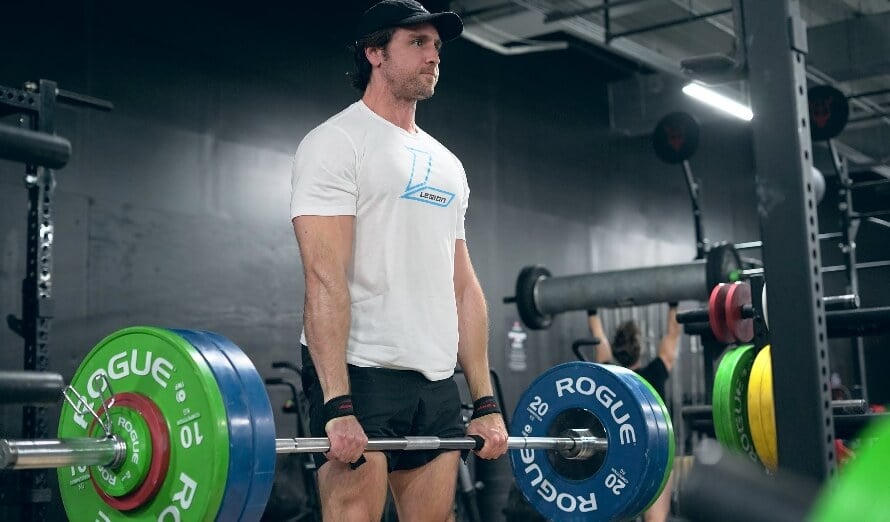
What Is the Deficit Deadlift?
A deficit deadlift is a variation of the conventional deadlift where you stand on an elevated surface, like a weight plate or platform, to increase the range of motion.
Here’s how it looks:
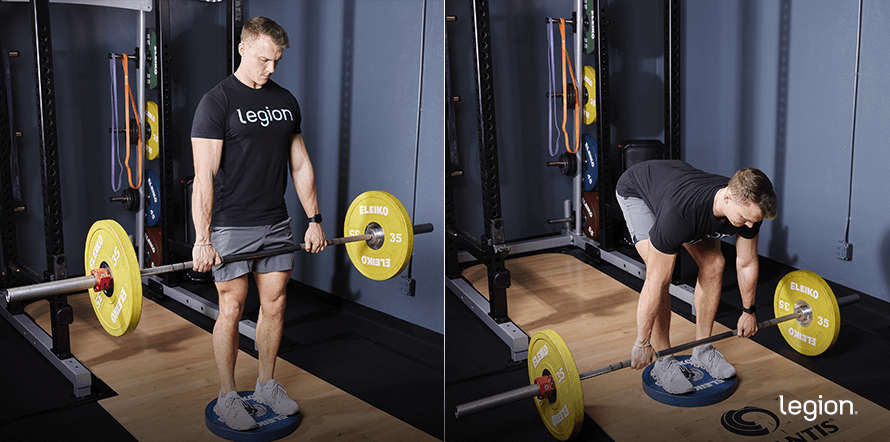
You might also hear it called the “elevated deadlift” or “raised deadlift,” but these terms refer to the same exercise.
How to Do the Deficit Deadlift
To learn how to deficit deadlift, split the exercise into three parts: set up, pull, and descend.
1. Set up
Before you tackle the deficit deadlift, you need to set the right deficit height. Finding the perfect deficit height for your proportions can take some experimenting.
As a general rule, a 2-inch deficit is a good place to start, though if you’re flexible or have long arms, a 3-inch deficit might be more fitting.
To create the deficit, you can use any sturdy surface elevated 2-to-3 inches off the floor. While there are specialized deficit deadlift platforms and blocks for this purpose, most weightlifters make do with a weight plate or a strong step.
Assuming you’re using a weight plate, here’s what to do: Place the weight plate on the floor, stand on it with a hip-width stance, and point your toes slightly outward. Roll a loaded barbell over your midfoot, positioning it about an inch from your shins.
Bend over and grab the bar with your palms facing you, just outside your shins. Take a deep breath to fill your belly with air, and brace your abs like you’re about to take a punch.
Push your hips up to flatten your back, and wedge yourself into a “half-squat” position. Pull your shoulder blades back and down, and squeeze your upper arms into your sides (imagine you’re crushing oranges in your armpits).
2. Pull
Squeeze the bar as hard as you can and pull it straight up.
Your hips and shoulders should rise simultaneously—don’t shoot your hips up and then use your back like a lever to raise your shoulders.
Once the bar passes your knees, push your hips into the bar. At the top of the rep, push your chest up and your shoulders down, but don’t lean back, hyperextend your lower back, or shrug the weight.
3. Descend
While keeping your back flat and your core tight, reverse the movement to return the bar to its starting position on the floor.
Don’t try to lower the bar slowly or quietly. The entire descent should take about a second. Take a moment to get in the proper starting position, then start your next rep.
Here’s how it should look when you put it all together:
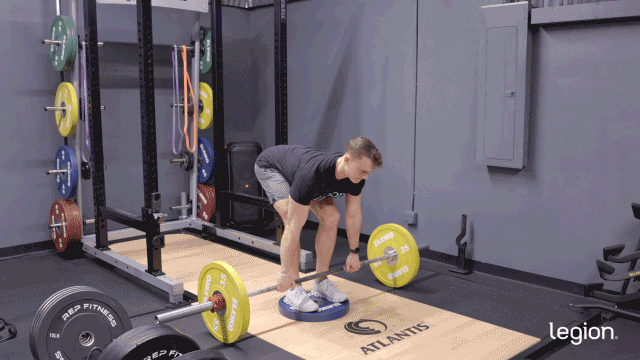
Deficit Deadlift Benefits
Enhanced Deadlift Performance
Pulling the bar off the floor is the hardest part of the deadlift for most weightlifters. Performing deadlifts with a deficit forces your muscles to work harder through this weak range of motion, improving your performance when you return to conventional deadlifting.
Reduced Injury Risk
Muscle imbalances between the quadriceps and hamstrings are a major cause of lower body injuries, especially to the hamstrings and ACL. Deficit deadlifts strengthen the hamstrings, which many people neglect. This helps correct strength imbalances, potentially reducing your risk of injury.
Improved Athletic Performance
The deficit deadlift trains many major muscle groups throughout the body, especially, the glutes, hamstrings, quads, and back. Strengthening these muscles enables them to generate more force, which boosts your ability to perform athletic movements like sprints and jumps.
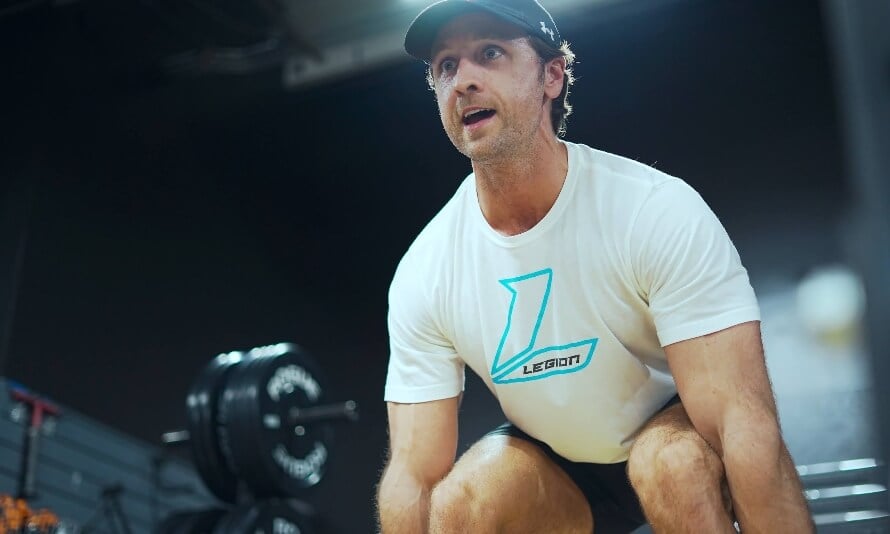
The Best Deficit Deadlift Variations
1. Deficit Sumo Deadlift
The sumo deficit deadlift works the same muscles as the regular deficit deadlift but emphasizes the quads more and the lower back less. It’s a great alternative if the standard version bothers a pre-existing back issue. Just remember, it requires more hip mobility, so it might not be ideal if you have limited flexibility.
RELATED: The Definitive Guide to the Sumo Deadlift
2. Deficit Romanian Deadlift
The deficit Romanian deadlift stretches your hamstrings more than the regular version, which research shows may aid growth. That said, it also requires significantly more flexibility, so it may not be suitable for everyone.
RELATED: How to Do the Romanian Deadlift: Form, Benefits, and Variations
3. Deficit Stiff-Leg Deadlift
The deficit stiff-leg deadlift is almost the same as the deficit Romanian deadlift, except you keep your legs straighter and lower the bar to the floor at the end of each rep. Both exercises effectively train your glutes, hamstrings, and lower back, but the stiff-leg version is harder to learn and can be uncomfortable. That’s why I usually prefer and recommend the deficit Romanian deadlift.
RELATED: How to Do Stiff-Leg Deadlifts: Form, Muscles Worked & More
FAQ #1: Are deficit deadlifts harder?
Yes, deficit deadlifts are harder than regular deadlifts because they have a larger range of motion. They also force your muscles to work more at the bottom of each rep, which is usually the part of the movement where you’re weakest.
FAQ #2: Are deficit deadlifts good?
Yes, deficit deadlifts are excellent for building muscle in your posterior chain (the muscles on the back of your body) and improving your deadlift strength. They also help fix weak points that can lead to injury and boost athletic performance.
FAQ #3: What does the deficit deadlift work?
The main muscles worked by the deficit deadlift are:
- Latissimus dorsi (lats)
- Trapezius (traps)
- Rhomoids
- Spinal erectors (lower back)
- Glutes
- Hamstrings
- Quadriceps (quads)
- Core
Here’s how these upper body muscles look (minus the core):
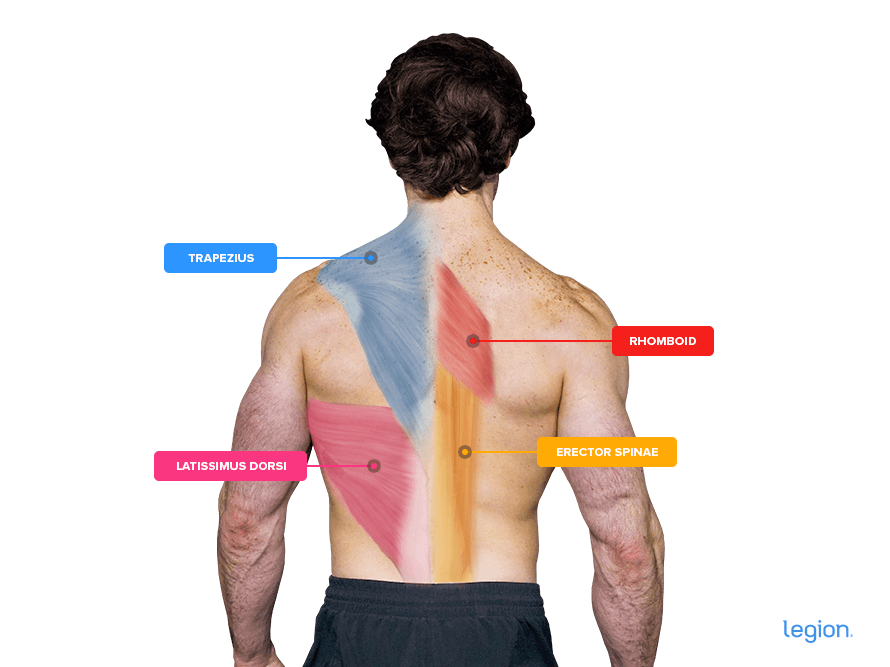
And here’s how the lower body muscles look:
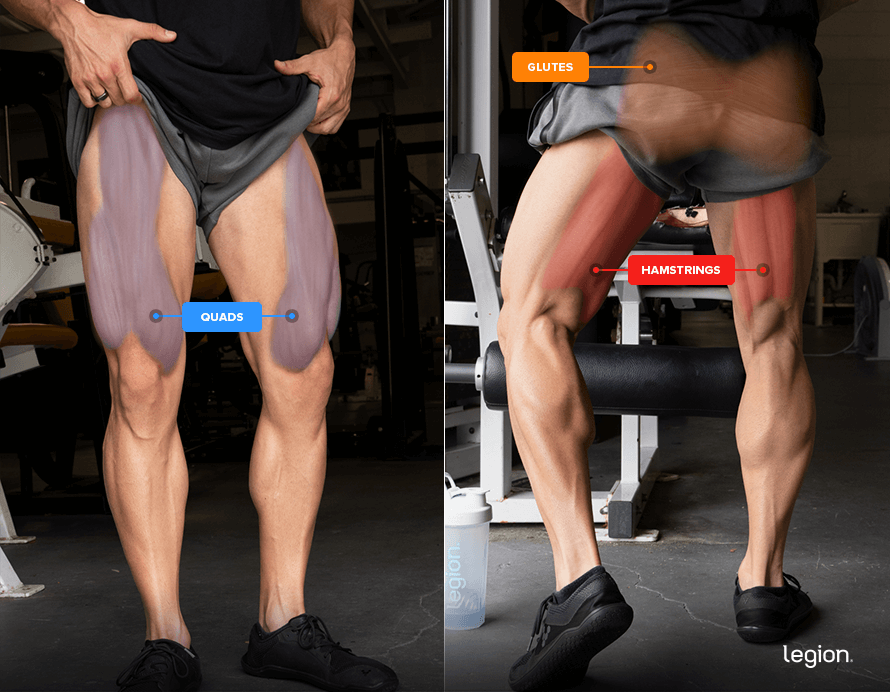
RELATED: What Muscles Do Deadlifts Work? An Answer, According to Science
Scientific References +
- K. Beckham, George, et al. “Isometric Strength of Powerlifters in Key Positions of the Conventional Deadlift.” Journal of Trainology, vol. 1, no. 2, 2012, pp. 32–35, https://doi.org/10.17338/trainology.1.2_32. Accessed 18 Apr. 2019.
- Kompf, Justin, and Ognjen Arandjelović. “Understanding and Overcoming the Sticking Point in Resistance Exercise.” Sports Medicine, vol. 46, no. 6, 12 Jan. 2016, pp. 751–762, https://doi.org/10.1007/s40279-015-0460-2. Accessed 6 Dec. 2019.
- Holcomb, William R., et al. “Effect of Hamstring-Emphasized Resistance Training on Hamstring:Quadriceps Strength Ratios.” The Journal of Strength and Conditioning Research, vol. 21, no. 1, 2007, p. 41, https://doi.org/10.1519/r-18795.1.
- Begalle, Rebecca L., et al. “Quadriceps and Hamstrings Coactivation during Common Therapeutic Exercises.” Journal of Athletic Training, vol. 47, no. 4, July 2012, pp. 396–405, www.ncbi.nlm.nih.gov/pmc/articles/PMC3396299/, https://doi.org/10.4085/1062-6050-47.4.01.
- Seitz, Laurent B., et al. “Increases in Lower-Body Strength Transfer Positively to Sprint Performance: A Systematic Review with Meta-Analysis.” Sports Medicine, vol. 44, no. 12, 25 July 2014, pp. 1693–1702.
- Thompson, Brennan J, et al. “Barbell Deadlift Training Increases the Rate of Torque Development and Vertical Jump Performance in Novices.” Journal of Strength and Conditioning Research, vol. 29, no. 1, 2015, pp. 1–10, www.ncbi.nlm.nih.gov/pubmed/25226322, https://doi.org/10.1519/JSC.0000000000000691.
- Boone, Tommy, et al. Journal of Exercise Physiologyonline Editor-In-Chief JEPonline Electromyographic Activity of Lower Body Muscles during the Deadlift and Still-Legged Deadlift. Vol. 16, no. 3, 2013, www.asep.org/asep/asep/JEPonlineJUNE2013_Miranda.pdf.










